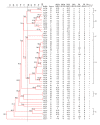Prevalence and Genetic Characterization of Carbapenem- and Polymyxin-Resistant Acinetobacter baumannii Isolated from a Tertiary Hospital in Terengganu, Malaysia
- PMID: 25006521
- PMCID: PMC3977555
- DOI: 10.1155/2014/953417
Prevalence and Genetic Characterization of Carbapenem- and Polymyxin-Resistant Acinetobacter baumannii Isolated from a Tertiary Hospital in Terengganu, Malaysia
Abstract
Nosocomial infection caused by Acinetobacter baumannii is of great concern due to its increasing resistance to most antimicrobials. In this study, 54 nonrepeat isolates of A. baumannii from the main tertiary hospital in Terengganu, Malaysia, were analyzed for their antibiograms and genotypes. Out of the 54 isolates, 39 (72.2%) were multidrug resistant (MDR) and resistant to carbapenems whereas 14 (25.9%) were categorized as extensive drug resistant (XDR) with additional resistance to polymyxin B, the drug of "last resort." Pulsed-field gel electrophoresis analyses showed that the polymyxin-resistant isolates were genetically diverse while the carbapenem-resistant isolates were clonally related. The 14 XDR isolates were further investigated for mutations in genes known to mediate polymyxin resistance, namely, pmrCAB, and the lipopolysaccharide biosynthesis genes, lpxA, lpxC, lpxD, and lpsB. All 14 isolates had a P102H mutation in pmrA with no mutation detected in pmrC and pmrB. No mutation was detected in lpxA but each polymyxin-resistant isolate had 2-4 amino acid substitutions in lpxD and 1-2 substitutions in lpxC. Eight resistant isolates also displayed a unique H181Y mutation in lpsB. The extent of polymyxin resistance is of concern and the novel mutations discovered here warrant further investigations.
Figures

References
-
- Park YK, Choi JY, Shin D, Ko KS. Correlation between overexpression and amino acid substitution of the PmrAB locus and colistin resistance in Acinetobacter baumannii . International Journal of Antimicrobial Agents. 2011;37(6):525–530. - PubMed
LinkOut - more resources
Full Text Sources
Other Literature Sources

